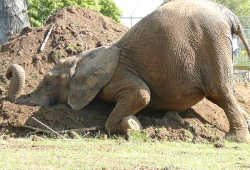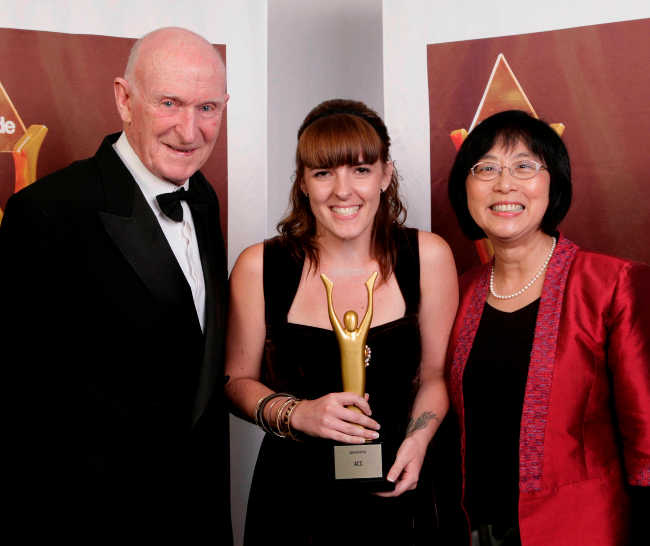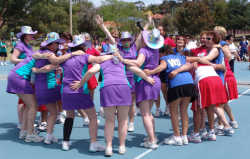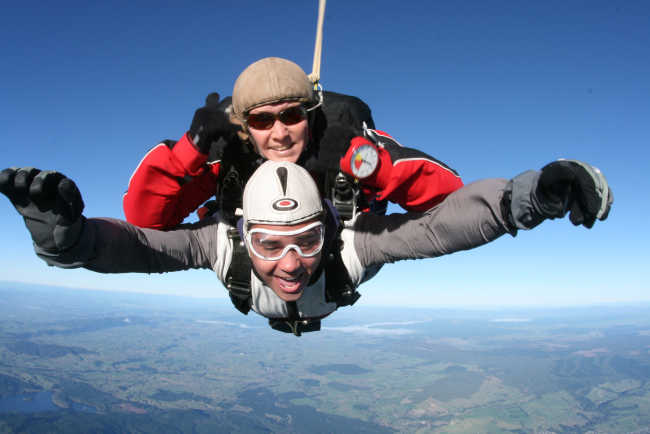An interview with Roger Morris Dorothy – 16/08/02
Roger Morris is becoming increasingly well-known as one of New Zealand’s serious painters, but it took a long time for him to realise that painting was to be his life work. Others who feel uncertain about what direction their lives should follow will take courage from reading about Roger’s experiences.
When did Roger start to paint? “Even when I was a child I was always busy – often making things, but equally often destroying things – pulling things apart and not always managing to put them together again! My mother became quite concerned at what this destructiveness meant until a doctor whom she respected and trusted assured her that destructive children often later showed a lot of creativity.”
Perhaps ‘later’ was the word that should have been stressed, because Roger had a lot of life experience that didn’t enhance creativity before he recognised where his talents lay.
The main creative influences in his formative years from his teens until the turning point towards painting were the great musical and literary artists of our time – musicians/poets like Bob Dylan, Neil Young, Leonard Cohen and Joni Mitchell and writers like John Steinbeck, Jack Carroll and Jack Kerouac. Visual artists didn’t reach him as he didn’t know them. The main impact on his visual senses was from photographs, most specifically the pictures from Vietnam or other war images. When he did respond to painting he was drawn to earlier European painters like Picasso and Matisse, or from further back Degas, Goya, Rembrandt, Breughel, Hogarth and Turner – fantastic to him because they painted the truth.
Search for a career Art was never presented to Roger as an option for a career. At Medbury Preparatory School and Christchurch Boys’ High School boys were shown as options for a career choice only the “manly” careers that society had decided were suitable for young men, and when he left school he had been given no training that suited his temperament, except technical drawing and English.
At the end of school, when he was feeling completely lost, a friend called and said he was going that day – right then – to join the police and invited Roger to go with him. Roger had never had the least involvement with the police force – not even in family conversations about life, and he had certainly never contemplated police work as a career. However, having no other plans he went with his friend, was accepted, trained for nineteen months, and worked for about the same length of time.
As a contrast to the demands of his work Roger created plastic models, painted them and spent all hours in the world of his imagination. This release for his imagination and creative skills kept that side of his nature alive while he was training and working as a policeman and experiencing violence directed against him because he was in a police uniform or coping with the results of violence against others. However, the discovery of painting as an actual adult reality was still to come.
While in the police force he met Mark Olivine (Ollie). They were both in some ways outsiders in the group and ended up skiing together, and then travelling overseas together.
During five years travelling, in Europe, the USA, Canada, Mexico, India and Israel, Roger started drawing and writing in books, bought a guitar and played it, and listened to music.
He supported himself by working at any job he could find. He taught skiing in Austria, and met a Londoner who trained Roger and Ollie to install hot water central heating systems, so they worked for him for some time in London. Roger also worked as a bus boy, a kitchen hand, and a labourer on many different sites.
“I visited a couple of galleries, but even then I didn’t know there was such a thing as an art world and art was still not an option,” Roger explained. “My writings and drawings were a struggle to put something down that made sense of what we were doing. We were searching to find what would be our life work, but not finding it. Even after seeing fantastic works by Leonardo da Vinci and other great artists it never clicked that art could be an option for me.”
A turning point A turning point came when Roger went on to Denmark where “the climate was cold but the people were warm.” He lived with young Danes and this was his first transition point, finding friends for himself, discovering life for himself. One of the new friends was a sound recorder for punk bands and had built his own recording studio (two steps down) and Roger started drawing record covers and drawing what he saw out the window.
He came back to New Zealand for family reasons, via India where he got very sick with dysentery, but was very sorry to leave Copenhagen and had serious misgivings about returning to Aotearoa/NZ. He was still troubled by sickness and unhappy about having returned. He felt trapped.
Roger takes up the account. “I was lying on the lawn feeling pretty sad and sorry for myself, and Mum gave me a little nudge. She said, ‘Remember that you can draw.’ Within the half hour I had got up and drawn how bad I was feeling. Whatever took place there was a transference of energy that explained to me what art is. Transferring the terrible feelings I was suffering on to paper was me going through a keyhole that opened just long enough for me to get through, and it gave me hope again. I realised in that moment not only that I could do it and had been leaning towards it all my life, but that I would do it – and I’ve been painting ever since – for twenty two years now.”
The only time he has stopped – though it wasn’t really a stop as he and Marianne painted throughout – was to build the house and two studios in which he and Marianne lived and worked.
Search for the art world Roger sought the art world and a network and some practical skills like stretching a canvas. He started by going to Hagley High School night class, starting in August 1980 and in three months did a whole year’s work and passed Bursary Art. He was accepted in Art School at Ilam in Christchurch and Elam in Auckland, and chose Elam because he wanted to study in a new environment away from Christchurch where he felt trapped and had seen so much violence when in the police force.
He was alone in Auckland and he loves it as the city where he did his first real work as an adult painter. After one term he gave up the course at Elam as it was not giving him what he felt he needed. He resolved to succeed in his work or die.
A satisfying life at last His life was full and satisfying. This was 1980 and he was in the middle of the protests against the Springbok Rugby Tour. He was really living. He didn’t mind starving, he wanted to paint, he wanted to work through the night – and he did. In his first studio in Mt Eden he painted in acrylics, as oils, which he believes are best, were too expensive and ‘the next step’.
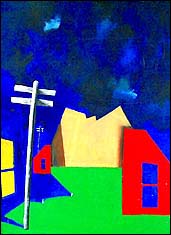 |
| First painting done in Mt Eden (Click here for a larger version) |
At first he painted to express the emptiness within him, but he moved beyond personal paintings to wider world images. As a child living in Central Otago with its vast spaces he was fascinated with maps and the vast unknown areas. Such preoccupations influence later paintings.
Roger explained, “The paintings are not singular, not just a self-realisation process, but by virtue of what you are doing everything else comes into it, even in portrait painting.”
Three years later in 1983 he met artist Marianne Muggeridge who had been painting full time for some years. She had graduated from Elam Art School in 1973 and then had been painting in London. As Roger described it, “We had both married our art, so there was no fear that one was going to take over from the other.”
They were both having fulfilling lives and if they did not make it together they were not going to fall apart.
At once there was a child on the way and they believed they must have a nest. Marianne had a house at Kapuni in Taranaki so they moved there. This was a total change in Roger’s life and it was certainly not the area he would have chosen, but the magnificence of Mt Taranaki became significant in his life.
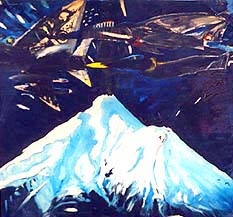 |
| Mountain with jet (Click here for a larger version) |
Roger was a complete novice as a builder, but he built a studio (29m x 7m)next to the house. Later he and Marianne sold this property and bought land at Oeo Rd and lived in a very old house while building two studios and a house on the property – a project that took two years.
Carving in Taranaki stone One extraordinary discovery – probably another transition point – while they were living in Taranaki was the Taranaki stone they were living on, which in Roger’s view is the best in New Zealand for carving. He became very enthusiastic about carving, but was glad that a recent move to Wellington has allowed him to focus on his painting without the distraction of carving.
What are the themes of Roger’s art? Roger explained that loneliness, the sense of feeling lost, fear, mystery, death and the fragility of love are predominant themes in his paintings.
“I remember when I was thirteen at Boys’ High being captivated by the chance discovery of photographs of bodies taken at Auschwitz.
“Dad was almost mistaken for a Jewish man at Terezin concentration camp and taken away and shot, until the group of New Zealand soldiers who were prisoners of war (captured in Crete where Dad was wounded) managed to convince the guards of their identity and explain that their heads were shaved only because of lice.
“I believe that some of the knowledge of the horror of what he saw there was transferred through the chromosomes to his sons. I believe that knowledge is passed on in a very deep nature from generation to generation. Dad passed on to me the realisation of what that moment meant in time – Nazism, Fascism, the bully – and that is part of my art too.”
Roger continued: “But it is also connected with another huge part of my particular story – the awareness of the dichotomy within between violence participation and nurturing love. This was generated in my case through the farming practices we had undergone as children growing up, loving and looking after animals whom we found gentle and good creature friends, yet ultimately having to face their going to dismal death: slit throats in trucks to ‘the works’, much like the populations of the holocaust in cattle trucks. These forces were identified and immediately collided and are still at war, within me and out there, in the world right now directing us. Art is the language of saying things that can’t be said.”
With what is happening in the world today Roger sees a great polarisation, with overpopulation, vast arms manufacturing, gigantic industry, and wars over resources as signs of dangerous times to come. The feelings of powerlessness and destruction are part of his art, but also he is moved by the way people care for each other, for the earth and for animals. He is moved to paint the contradictions and the ironies in it all.
Impact of really great art Roger described the impact on him of really great art. “I’d seen paintings by Rembrandt, I’d seen drawings by da Vinci, and these hit me with their concrete physical presence as I walked into that room. Although at that time I didn’t have the language for them I was aware of them and I kept returning to look at them again. They gave me the knowledge that although in painting we are working on a one-dimensional plane what we are trying to do is to make it three-dimensional. Every so often it happens – it works and that’s great art! It’s like music or poetry – what counts in music is the feeling that those notes give you, not the notes themselves, and what counts in poetry is the sum of the words and the feelings they inspire. The best in all these fields gives you something, hands something to you. Compared with these there is so much dross in the modern era because people think art is just putting stuff down and it does not matter what it is.”
When he begins to paint he is very aware of the wonderful works behind him and knows that it is against those that he will be judged.
Impact of the Internet Roger values how the Internet gives access to art around the world. Through contact on the Internet he has a print in the St Petersburg Museum of Non-Conformist Art.
From a website set up with some of his paintings on it, Roger has received a lot of valuable feedback. A Russian woman, Catherine Yakovina, showed great enthusiasm for the paintings, so as an appreciation Roger sent her a print.
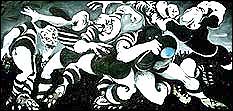 |
| Man Meet Man (Woodblock Print) (Click here for a larger version) |
The print was included in a show in St Petersburg called “War and the Consciousness of the Painter” (1999), and then put in the drawers of the Museum of Non-Conformist Art.
For Roger, this tells him that his art is out there and recognised powerfully because to him St Petersburg (Stalingrad) is one of the most powerful spots on earth as it is where the Germans were first stopped in World War 2.
Admiration for the work of Marianne Muggeridge As I talked to Roger it became very clear that the contemporary New Zealand painter whose works most impress him is his partner Marianne Muggeridge. He sees a great future for her.
They paint in different styles and on different subjects. I see them both as having a formative role in the development of New Zealand painting in the twenty first century.

